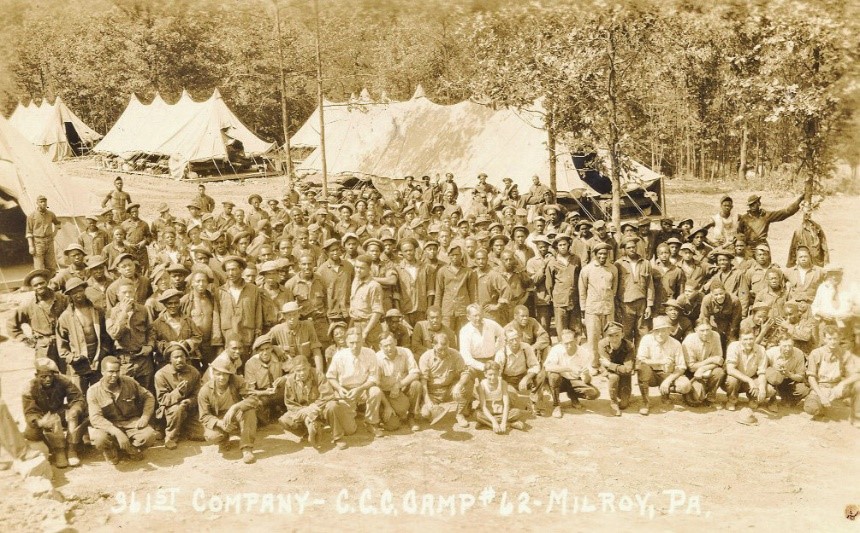The Civilian Conservation Corps was a government jobs program, conceived during the Great Depression, that put thousands of unemployed men to work primarily in state and national parks and forests, including four sites in Centre County.
The CCC was one of the New Deal government programs that President Franklin D. Roosevelt proposed soon after taking office in 1933. Its goal was to provide both jobs and room and board for young men to help them weather the Depression and emerge with useful skills. It also aimed to reforest American wildlands, build public parks, and provide a network of roadways and service buildings in remote areas.
Initially called the Emergency Conservation Work program, the CCC recruited unmarried, unemployed men, ages 18-25, whose families were on some form of government assistance. In 1935, the age limit was raised to 28 years. In mid-1933, the CCC opened enrollment to United States Army veterans from World War I.

Pennsylvania was second only to California in the number of CCC camps, in part because Governor Gifford Pinchot, a lifelong proponent of conservation who had served as the first head of the United States Forest Service, readily envisioned uses for manpower in the forests of Pennsylvania. Four of the state’s 151 camps were located in Centre County: S-62 in Harris Township, S-63 in Penn and Haines townships, and S-71 and S-119 in Rush Township. (The “S” identified the camps as part of the state parks division of the CCC.)
Centre County’s CCC enlistees came from all over Pennsylvania. They were assigned to camps that were run by the U.S. Army but supervised by civilian foremen and local employed men or LEMs as they were known. These supervisors were foresters and skilled workers such as carpenters, masons, mechanics, and plumbers whose expertise was matched with a camp’s needs.
A CCC worker committed to a minimum of six months and could remain in the corps for two years. Upon arrival at his designated camp, he was issued uniforms, a bed in army-style barracks, and three meals a day. He also had access to a medical dispensary and army chaplains. For his 40-hour work week, the CCC paid him $30 a month of which he could keep at least $5 for his personal needs, including a monthly haircut. He was required to send $22-25 back home to his family.
The Centre County CCC transformed wilderness areas. Workers built roads, bridges, dams, fire lookout towers, and picnic pavilions. They created swimming areas, hiking trails, and fish hatcheries. They worked on soil and water conservation and flood control projects. They built the earthen and masonry dams that created lakes at Poe Valley and Black Moshannon state parks.
In their free time, the young men had opportunities for recreation or to take evening classes in English, math, and other subjects. They could also learn skills such as stone masonry or blacksmithing.
Listen to “Dead Centre” podcast about the CCC
Black corps members were required to live and work in separate camps. Although the legislation creating the CCC mandated equal treatment for Blacks and Whites, in 1933 segregation was not considered legal discrimination. Black CCC workers received the same pay as their White counterparts, but their camps had fewer educational and vocational resources and scant opportunities for Blacks who aspired to leadership positions.
Camp S-62 was one of the state’s twelve segregated camp sites. Its members constructed many of the facilities in use today at Penn-Roosevelt State Park. In 1941, the army planned to transfer a company of Black veterans to Poe Valley, but the proposal was scuttled when Pennsylvania Senator Joseph Guffey reported local opposition to a second Black camp in the mostly all-White county.
Penn-Roosevelt, along with Black Moshannon, Poe Valley, and Poe Paddy are among the dozens of Pennsylvania state parks carved out of the wilderness by the CCC. A total of 194,500 Pennsylvanians worked in the state’s CCC camps. Nationally, the CCC was one of the most popular of the New Deal programs. A 1936 Gallup poll found that 82 percent of Americans supported it.
In 1942, with World War II raging and the military draft in effect, Congress voted to end the program. Congress allocated to the military any CCC assets — such as uniforms, cots, and equipment — deemed useful to the war effort. A few CCC structures still stand such as the officers’ quarters and the forestry quarters at Poe Valley and a stone bake oven at Penn-Roosevelt. Most of the structures at CCC campsites, however, were razed or dismantled and relocated.
Katie O’Toole
Sources:
Marcum, William. The Foreman’s Boys: The Story of Civilian Conservation Corps, Company 1333, Camp S-63, Poe Valley. Mechanicsburg, PA: Sunbury Press, 2019.
Speakman, Joseph M. At Work in Penn’s Woods: The Civilian Conservation Corps in Pennsylvania. University Park, PA: Penn State University Press, 2006.
Pennsylvania Department of Conservation & Natural Resources. The Civilian Conservation Corps. https://www.dcnr.pa.gov/StateParks/History/CCCYears/Pages/default.aspx (Accessed April 10, 2021)
First Published: May 20, 2021
Last Modified: April 22, 2022
